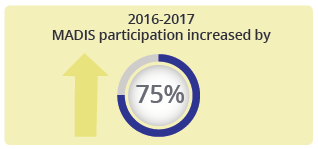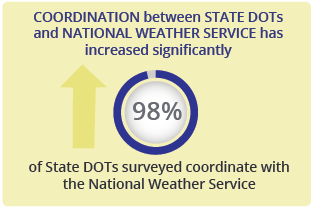2017 Road Weather Management Program Performance Measures UpdatePrintable Version [PDF, 1.4 MB]
U.S. Department of Transportation FHWA-HOP-17-054 October 2017

For the past 10 years, the Road Weather Management Program (RWMP) has periodically evaluated its effectiveness in helping improve the transportation system's performance during adverse weather using sources that include program records, literature reviews, Internet searches, and State DOT surveys.1 To date, four assessments have been conducted and reported in 2009, 2011, 2013, and 2015. This flyer summarizes the current progress, successes, and needs relating to the practice of road weather management in the United States from the 2017 performance measure data and evaluation. Road Weather Management Impacts AssessmentNationwide implementation of various road weather management (RWM) strategies has the potential to provide meaningful improvements in highway performance during adverse weather. State DOTs are working to understand the performance of their transportation systems and the benefits of road weather management. Some examples include publishing winter maintenance reports, providing online dashboards, calculating a winter severity index (WSI), and evaluating the return on investment (ROI) of RWM strategies. The RWMP monitors national trends pertaining to weather-related expenditures, delays, and safety. While this information provides insight into the impacts of weather and the activities undertaken by transportation agencies, it is often a challenge to attribute any trends to RWMP activities. However, examples of RWM practices that demonstrate benefits were identified:
Adverse weather conditions significantly affect the safety and mobility of the roadway network. FHWA's Road Weather Management Program (RWMP) seeks to better understand the impacts of weather on roads and promotes strategies to mitigate those impacts. The objectives that guide the RWMP's activities and direction include:
Application of Road Weather Management Tools and TechnologiesThe RWMP promotes a variety of innovative tools and technologies for adoption by transportation agencies. One set of tools pertains to the collection of fixed and mobile road weather observations, which can be real-time or archived road weather data. Overall, the number of State agencies that use these types of data collection systems have increased for the majority of the tools assessed, which suggests progress towards widespread adoption. For example, the number of State DOTs participating in the Meteorological Assimilation Data Ingest System (MADIS) Program has increased (see Figure 1). MADIS is a system that offers a robust set of quality data at the national level that is available to support transportation operations, inform decision making and performance measurement, and provide road weather conditions to the public.  Figure 1. State DOTs participating in the Meteorological Assimilation Data Ingest System (as of June 2017). State DOTs reported high usage for products or services to support their RWM strategies, as shown below:

The number of States collecting real-time data should continue to grow as the Weather-Savvy Roads Initiative is being promoted in EDC-4. Connected vehicle technology for RWM is emerging with 17 percent of State DOTs reporting development of applications or tools that leverage infrastructure-to-vehicle (I2V) or vehicle-to-infrastructure (V2I) connectivities. Maintenance decision support systems (MDSS) have historically shown significant benefits to agencies including cost savings and improved highway operations. However, the 2017 assessment indicated a slight decrease in adoption of this strategy and an increase in the number of States saying they do not need an MDSS. Weather-responsive traffic analysis, modeling, and simulation tools are rarely used throughout the Nation, with 95 percent of States surveyed either not using or being unaware of whether their agency utilizes this type of tool. Road Weather Management Capacity Building
Capacity building refers to providing RWMP stakeholders with flexible, accessible learning and growth through training, technical assistance, and educational resources. The RWMP accomplishes this through stakeholder meetings, road weather research and development (R&D) projects, training programs, conferences, webinars, and other activities. Road weather-related meetings have been well attended. The RWMP meetings and the Weather Responsive Traffic Management (WRTM) meeting attracted between 23-27 State DOTs per event. In 2015, the RWMP began hosting Road Weather Roundtables webinars. The EDC-4 Summits, which introduced the Weather-Savvy Roads Initiative drew 48 States along with the District of Columbia and the Virgin Islands. 
Developed in 2014, the RWM Capability Maturity Framework (CMF) tool, which helps agencies identify their strengths and weaknesses and develop action plans for implementing improved RWM capabilities, has generated interest throughout the country. Partnerships and Stakeholder CollaborationThrough partnerships and stakeholder collaboration, the RWMP utilizes a multidisciplinary approach to address road weather challenges. By partnering with State DOTs on research projects and attending and presenting at conferences, workshops, or meetings, the RWMP builds partnerships that advance road weather innovations and practices. The RWMP also promotes data sharing and information exchange opportunities to support a comprehensive approach. 
The RWMP partners with transportation agencies to conduct various research, development, deployment and training initiatives, such as Pathfinder, RWM CMF, Weather Responsive Traffic Management, Weather Data Environment, and the Integrated Mobile Observations (IMO) project. The RWMP also supports the National Oceanic and Atmospheric Administration by working with State DOTs to secure data sharing agreements and helping to ensure data quality by integrating quality checking algorithms into MADIS. Participation in the MADIS program is tracked by the number of State DOTs that have signed a data sharing agreement. The level of coordination between State DOTs and the National Weather Service (NWS) has also significantly increased since the last assessment. Almost all respondents (39 of 40) reported at least some level of coordination with the NWS local forecast office. This coordination effort reflects a strong commitment to enhancing the performance of road weather management and operations activities.   What's Ahead for the Road Weather Management Program?The results of the 2017 performance measures update show an engaged stakeholder community, new and strengthened partnerships, and sustained use of available technologies for RWM. This assessment continues to be important for the RWMP and provides direction for the program in advancing road weather strategies. As a result, the RWMP will consider and explore the following recommendations:

U.S. Department of Transportation • Road Weather Management 1200 New Jersey Avenue, E86-318 • Washington, DC 20590 Roemer Alfelor • 202-366-9242 • Email: roemer.alfelor@dot.gov https://ops.fhwa.dot.gov/weather/ 1 A total of 40 State DOTs participated in the survey during the spring of 2017. State DOT statistics presented are based on these responses. [Return to Note 1] 2 Idaho Transportation Department, The Transporter, "ITD sees drop in accidents on icy roads thanks to electronic spreader control system," January 8, 2016. [Return to Note 2] 3 "Iowa's Salt Dashboard Helps Garages Use Salt Efficiently," Winter Maintenance Newsletter, August 2016. [Return to Note 3] 4 Federal Highway Administration, Michigan Department of Transportation (MDOT) Weather Responsive Traveler Information (Wx-TINFO) System, FHWA-JPO-16-324 (Washington, DC: 2016). [Return to Note 4] |
|
United States Department of Transportation - Federal Highway Administration |
||